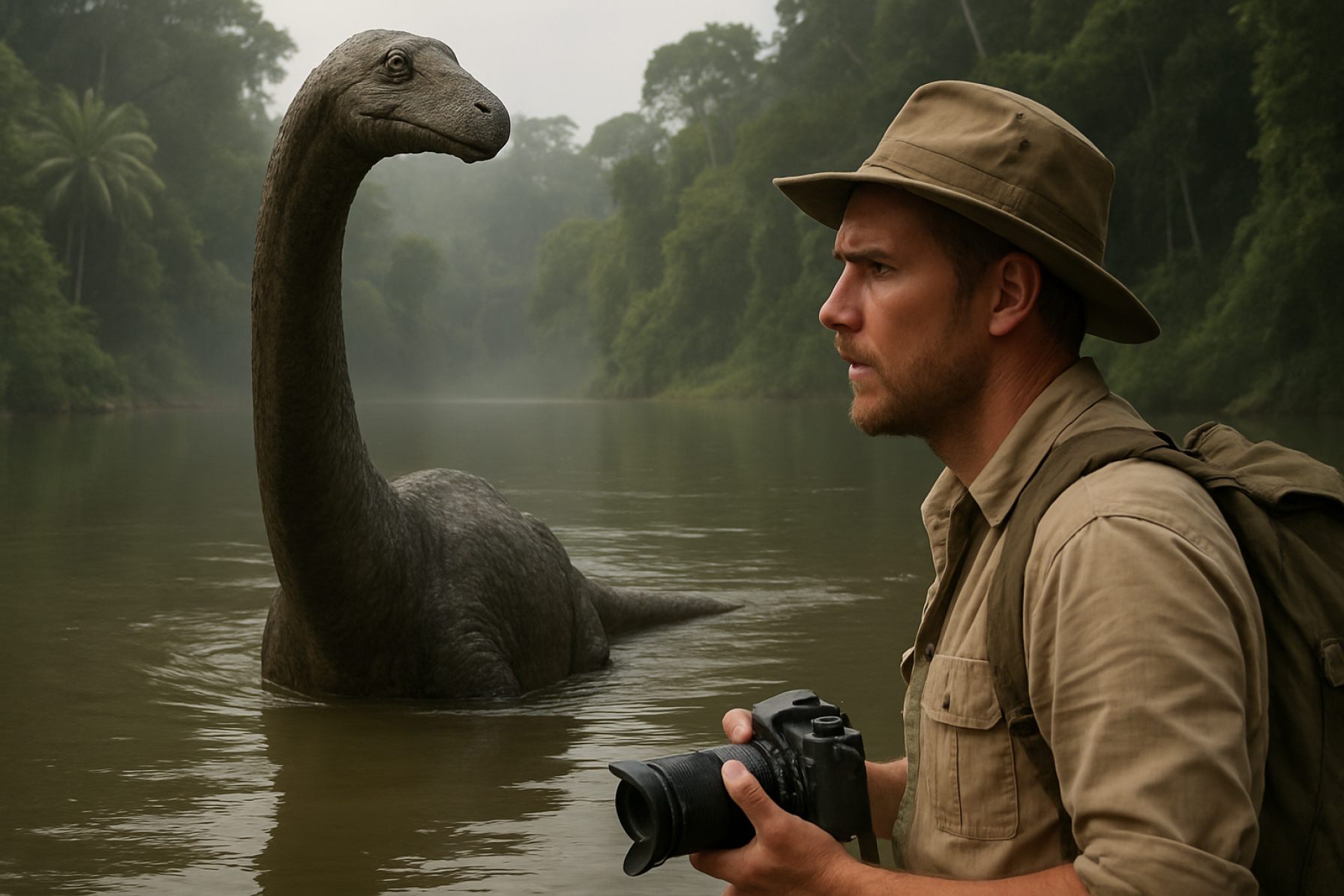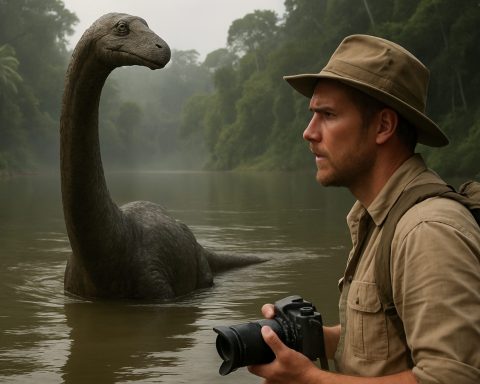Inside the Search for Mokele-mbembe: Cutting-Edge Cryptid Research in the Heart of the Congo. Discover the Evidence, Expeditions, and Controversies Surrounding Africa’s Legendary Dinosaur.
- Introduction: The Legend of Mokele-mbembe
- Historical Sightings and Indigenous Accounts
- Scientific Expeditions and Field Research
- Physical Evidence: Tracks, Photographs, and Testimonies
- Ecological and Biological Considerations
- Skepticism and Debunking: The Scientific Community’s View
- Cultural Impact and Media Representation
- Future Directions in Mokele-mbembe Research
- Conclusion: The Ongoing Mystery
- Sources & References
Introduction: The Legend of Mokele-mbembe
The legend of Mokele-mbembe, often described as a large, long-necked creature inhabiting the remote swamps and rivers of the Congo Basin, has captivated explorers, cryptozoologists, and the public for over a century. Rooted in the oral traditions of the indigenous peoples of Central Africa, the creature’s name translates to “one who stops the flow of rivers” in the Lingala language. Western awareness of Mokele-mbembe began in the early 20th century, when missionaries and colonial officials reported hearing stories of a mysterious animal resembling a sauropod dinosaur. These accounts sparked a wave of expeditions and scientific curiosity, positioning Mokele-mbembe as one of the most enduring cryptids in modern folklore Natural History Museum.
Despite numerous expeditions and anecdotal reports, no conclusive physical evidence has been found to confirm the existence of Mokele-mbembe. The legend persists, fueled by eyewitness testimonies, ambiguous photographs, and the allure of the unexplored Congolese wilderness. Researchers approach the subject from various perspectives, ranging from zoological investigation to anthropological study of local beliefs and environmental conditions. The ongoing search for Mokele-mbembe highlights the intersection of science, myth, and the human fascination with the unknown, making it a focal point for debates about the boundaries of cryptozoology and the challenges of investigating elusive creatures in remote habitats Smithsonian Magazine.
Historical Sightings and Indigenous Accounts
Historical sightings and indigenous accounts form the backbone of Mokele-mbembe cryptid research, providing the earliest and most persistent evidence for the creature’s existence. The legend of Mokele-mbembe, often described as a large, long-necked, semi-aquatic animal, originates from the oral traditions of the Baka, Aka, and other indigenous peoples inhabiting the Congo Basin. These communities have recounted stories of a mysterious beast inhabiting the remote swamps and rivers, particularly the Likouala region, for generations. Descriptions consistently emphasize its massive size, herbivorous diet, and aggressive territorial behavior, especially toward canoes and fishermen.
The first documented Western encounter dates back to the early 20th century, when German explorer Paul Gratz published accounts of a creature matching the local descriptions in his 1909 book. Subsequent colonial-era reports, such as those by French missionary Abbé Lievain Bonaventure, further fueled Western interest, often blending indigenous testimony with explorers’ own observations. Notably, the 1980s saw a surge in expeditions inspired by these accounts, with researchers like Roy Mackal and James Powell interviewing local witnesses who provided consistent details about the animal’s appearance and habits Natural History Museum.
While skeptics argue that these sightings may be misidentifications of known animals or cultural myths, the persistence and consistency of indigenous narratives continue to intrigue cryptozoologists. These accounts remain a primary source of data, guiding modern expeditions and shaping the ongoing search for Mokele-mbembe in the dense, largely unexplored forests of Central Africa.
Scientific Expeditions and Field Research
Scientific expeditions and field research into the Mokele-mbembe cryptid have been ongoing since the early 20th century, primarily focused on the remote swamps and river systems of the Congo Basin. Researchers, both independent and affiliated with academic institutions, have sought to gather empirical evidence—such as physical remains, tracks, or clear photographic documentation—of this alleged sauropod-like creature. Despite numerous expeditions, including those led by biologists, zoologists, and cryptozoologists, conclusive proof of Mokele-mbembe’s existence remains elusive.
Notable scientific efforts include the 1980 and 1981 expeditions by Dr. Roy Mackal, a University of Chicago biologist, who conducted interviews with local inhabitants and collected anecdotal reports, but failed to obtain physical evidence. Subsequent expeditions, such as those organized by the Natural History Museum and the Smithsonian Institution, have similarly relied on eyewitness testimonies and environmental surveys. These teams often face significant logistical challenges, including difficult terrain, political instability, and the region’s dense vegetation, which complicate systematic searches and the deployment of modern equipment.
While some expeditions have reported indirect evidence—such as unusual tracks or unexplained disturbances in the water—these findings have not withstood scientific scrutiny. Critics argue that the lack of verifiable data, combined with the high potential for misidentification of known animals, undermines claims of Mokele-mbembe’s existence. Nevertheless, the persistence of field research underscores the enduring fascination with this cryptid and the broader quest to explore the world’s remaining biological mysteries.
Physical Evidence: Tracks, Photographs, and Testimonies
Physical evidence forms a cornerstone of Mokele-mbembe cryptid research, with investigators focusing on three primary categories: tracks, photographs, and eyewitness testimonies. Numerous expeditions to the Likouala swamps of the Republic of the Congo have reported the discovery of large, three-toed footprints, sometimes measuring up to a meter in length. However, the authenticity of these tracks remains contentious, as no castings or samples have yielded definitive proof, and some researchers suggest they could be misidentified prints of known animals such as elephants or rhinoceroses (Natural History Museum).
Photographic evidence is similarly inconclusive. While a handful of blurry images and videos have surfaced over the decades, none have withstood scientific scrutiny or provided clear, unambiguous depictions of an unknown animal. The dense vegetation and murky waters of the Congo Basin further complicate efforts to capture reliable visual documentation (Encyclopædia Britannica).
Eyewitness testimonies, often from local inhabitants and occasional Western explorers, remain the most abundant form of evidence. Descriptions are remarkably consistent, typically referencing a large, long-necked creature reminiscent of a sauropod dinosaur. However, the reliability of these accounts is debated, as they may be influenced by local folklore, misidentification of known fauna, or the desire to attract attention and tourism (Smithsonian Magazine). Despite decades of investigation, no physical evidence has yet conclusively established the existence of Mokele-mbembe.
Ecological and Biological Considerations
Ecological and biological considerations are central to evaluating the plausibility of the Mokele-mbembe’s existence in the Congo Basin. The region’s dense rainforests and extensive river systems provide a theoretically suitable habitat for a large, semi-aquatic animal. However, the ecological carrying capacity of the area raises questions. Large herbivorous animals require substantial food resources, and the flora of the Likouala swamps would need to support such a population without leaving obvious ecological traces, such as significant grazing patterns or altered vegetation, which have not been documented by field biologists or conservationists working in the region (WWF).
From a biological perspective, proponents often compare Mokele-mbembe to sauropod dinosaurs, suggesting a lineage that survived extinction events. However, the absence of fossil evidence for non-avian dinosaurs in Africa post-Cretaceous, and the lack of physical remains such as bones or scat, challenge this hypothesis (Natural History Museum). Additionally, the reproductive viability of a hidden population is questionable; a sustainable breeding group would likely leave more definitive signs, including tracks, nests, or carcasses, none of which have been reliably documented (IUCN).
In summary, while the Congo Basin’s environment is remote and biologically rich, current ecological and biological evidence does not support the existence of a large, undiscovered animal such as Mokele-mbembe. Ongoing research in the region continues to focus on biodiversity, but so far, findings have not substantiated cryptid claims.
Skepticism and Debunking: The Scientific Community’s View
The scientific community remains overwhelmingly skeptical regarding the existence of Mokele-mbembe, often cited as a living dinosaur in the Congo Basin. Mainstream zoologists and paleontologists argue that the evidence supporting the creature’s existence is anecdotal, relying heavily on local folklore, eyewitness accounts, and ambiguous photographs or footprints. No physical remains—such as bones, tissue, or DNA—have ever been recovered, despite numerous expeditions and decades of searching. This lack of verifiable evidence is a central point in the scientific critique, as the discovery of a large, unknown animal would require substantial biological and ecological support, which has not been observed in the region’s well-studied ecosystems.
Additionally, many scientists point out that the descriptions of Mokele-mbembe closely resemble outdated reconstructions of sauropod dinosaurs, suggesting that local reports may be influenced by popular media and earlier Western explorers’ interpretations rather than independent zoological phenomena. The region’s challenging terrain and the potential for misidentification of known animals, such as large monitor lizards or hippopotamuses, further complicate claims of a hidden megafauna. Peer-reviewed journals and organizations such as the Skeptics Society and the Natural History Museum have published critical analyses, emphasizing the importance of rigorous methodology and the pitfalls of confirmation bias in cryptid research.
In summary, while the legend of Mokele-mbembe persists in popular culture and cryptozoological circles, the scientific consensus is that there is no credible evidence to support its existence, and most claims are best explained by misidentification, folklore, or hoaxes.
Cultural Impact and Media Representation
The legend of Mokele-mbembe, often described as a sauropod-like creature inhabiting the Congo Basin, has had a profound cultural impact both within Central Africa and internationally. In local folklore, Mokele-mbembe is not merely a cryptid but a figure woven into the spiritual and cultural fabric of the region, often regarded with a mixture of reverence and fear. Its presence in oral traditions has influenced local attitudes toward the unexplored wilderness and the creatures believed to inhabit it, sometimes serving as a cautionary tale or a symbol of the unknown power of nature.
Internationally, Mokele-mbembe has captured the imagination of cryptozoologists, explorers, and the general public, becoming a recurring subject in books, documentaries, and speculative fiction. Media representations often oscillate between sensationalism and scientific curiosity, with documentaries such as those produced by the BBC and National Geographic exploring both the myth and the ongoing expeditions searching for evidence of the creature. These portrayals have contributed to the global fascination with the cryptid, fueling further expeditions and research, as well as debates about the boundaries between science and legend.
The cryptid’s depiction in popular culture—ranging from television specials to adventure novels—has also influenced public perceptions of Africa’s biodiversity and the mysteries of its rainforests. While some critics argue that such representations can perpetuate stereotypes or distract from genuine conservation issues, others contend that the enduring allure of Mokele-mbembe helps draw attention to the ecological and cultural richness of the Congo Basin, highlighting the importance of preserving both its natural and mythological heritage.
Future Directions in Mokele-mbembe Research
Future directions in Mokele-mbembe research are increasingly shaped by advances in technology, interdisciplinary collaboration, and a growing emphasis on environmental and cultural sensitivity. One promising avenue is the use of environmental DNA (eDNA) sampling, which allows researchers to detect genetic traces of organisms in water bodies without direct observation. This non-invasive method has already revolutionized the search for elusive species in other regions and could provide more definitive evidence regarding the presence or absence of large unknown animals in the Congo Basin (National Geographic).
Additionally, the integration of remote sensing technologies, such as drones and satellite imagery, offers new possibilities for mapping inaccessible swamp and river systems where Mokele-mbembe is reported. These tools can help identify potential habitats and migration corridors, guiding future expeditions more efficiently (NASA).
Collaboration with local communities and indigenous knowledge holders is also gaining recognition as essential. Their firsthand accounts and ecological expertise can inform research priorities and methodologies, ensuring that investigations are both respectful and contextually grounded (United Nations).
Finally, future research is likely to focus on the broader ecological and conservation implications of cryptid investigations. By framing the search for Mokele-mbembe within the context of biodiversity assessment and habitat preservation, researchers can contribute valuable data to conservation science, regardless of whether the cryptid itself is ever conclusively documented.
Conclusion: The Ongoing Mystery
Despite decades of expeditions, anecdotal reports, and scientific scrutiny, the mystery of Mokele-mbembe remains unresolved. The creature, often described as a sauropod-like animal inhabiting the remote swamps and rivers of the Congo Basin, continues to elude definitive discovery. While local legends and eyewitness testimonies persist, no conclusive physical evidence—such as bones, clear photographs, or DNA samples—has been produced to satisfy the standards of zoological verification. This ongoing absence of proof has led many in the scientific community to regard Mokele-mbembe as a cultural phenomenon rather than a biological reality, yet the allure of the unknown continues to inspire new generations of researchers and explorers.
Recent advances in technology, such as environmental DNA (eDNA) sampling and remote sensing, offer new avenues for investigation that may one day provide more definitive answers. However, the logistical and political challenges of conducting fieldwork in the Congo Basin remain significant obstacles. The region’s dense forests, difficult terrain, and limited infrastructure complicate sustained research efforts, while the need for collaboration with local communities and authorities is paramount for ethical and effective exploration. As such, Mokele-mbembe endures as a symbol of the world’s remaining mysteries—an intersection of folklore, scientific curiosity, and the enduring human fascination with the unknown. Until more concrete evidence emerges, the legend of Mokele-mbembe will likely persist, fueling both skepticism and hope within the cryptozoological community and beyond (Natural History Museum, Smithsonian Magazine).















